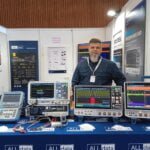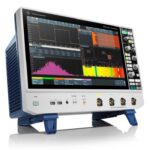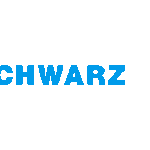
06 Feb Webinar ‘Oscilloscope Days 2025’ on April 2. 3., 2025
Become an expert oscilloscope user!
Learn from application oriented presentations – based on day to day testing challenges
The electrification and digitisation of everyday life brings new challenges to the daily work of engineers who need to increase functionality while reducing overall power consumption, weight and size, and still ensure device interoperability. All these different objectives lead to the need for thorough testing at both component and system level. In this two-day webinar, experts from Rohde & Schwarz, Würth Elektronik, PE System and Wolfspeed will show you how an oscilloscope, combined with the right probes and other accessories, can be used effectively in:
- Analyzing Signal Integrity of the transmission interfaces
- Doing conducted and radiated EMC precompliance measurements
- Qualifying AC losses and saturation effects in your power electronic stages and…
- An in-situ characterization of whole power electronic devices is needed.
Book your place in the calendar and register to:
The agenda
Day 1 – Wednesday, 02.04.2025
| Time (CET) | Title | Presenter |
| 09:30 – 9:45 | Welcome & introduction | Rohde & Schwarz |
| 09:45 – 10:15 | Opening keynote Without electronics, there is no power electronics. Therefore, it is essential to understand the interrelationship between semiconductor technologies to optimize performance of an electric power processing system and ensure product compliance. This keynote will firmly demonstrate how advancements in both novel microelectronics and power semiconductor devices are closely intertwined. Furthermore, the significant implications for system-level integration will be emphasized and a clear pathway for overcoming the challenges that arise will be presented. | Leonardo Montoya from Wolfspeed |
| 10:15 – 11:05 | Part 1: How to choose the best oscilloscope and probing for my testing needs? In this session, we will cover the fundamentals of oscilloscopes. What are the key elements of an oscilloscope, how much bandwidth and sampling rate do you need? We will also have a look at the possibilities of the digital trigger system, acquisition rate, FFT capabilities and much more. Probes are a fundamental part of oscilloscope measurements. Adding a probe to your system affects your signal and how you read it. Understanding the different types of probes and how to connect them to your DUT is key. Stay tune to know how to get the maximum out of your fundamental scope. | Sofia Perez-Simbor from Rohde & Schwarz |
| 11:05 – 11:15 | Question & Answer | |
| 11:15 – 11:30 | Break | |
| 11:30 – 12:20 | Part 2:
| Alexander Küllmer from Rohde & Schwarz Robert Schillinger |
| 12:20 – 12:30 | Question & Answer | |
| 12:30 | Wrap-up | Rohde & Schwarz |
Day 2 – Thursday, 03.04.2025
| Time (CET) | Title | Presenter |
| 09:30 – 09:45 | Welcome & introduction | Rohde & Schwarz |
| 09:45 – 10:45 | Part 3:
| Mohamed Al-Alami from Würth Elektronik Ian Jannasch |
| 10:45 – 11.00 | Question and Answer | |
| 11:00 – 11:15 | Break | |
| 11:15 – 12:15 | Part 4:
| Nicholas LeBas from Rohde & Schwarz Pasi Suhonen |
| 12:15 – 12:30 | Question & Answer | |
| 12:30 | Wrap-up | Rohde & Schwarz |






